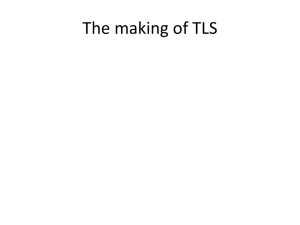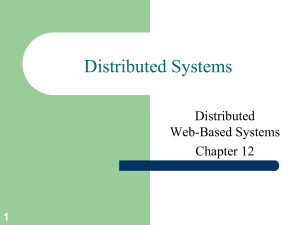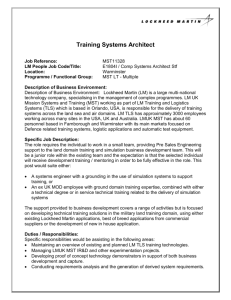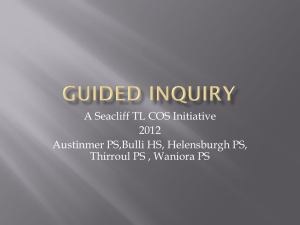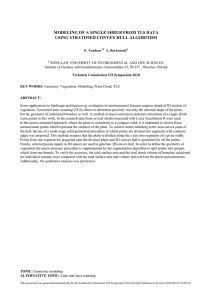ISPRS Archive Vol. XXXVIII, Part 4-8-2-W9, "Core Spatial Databases -...
advertisement
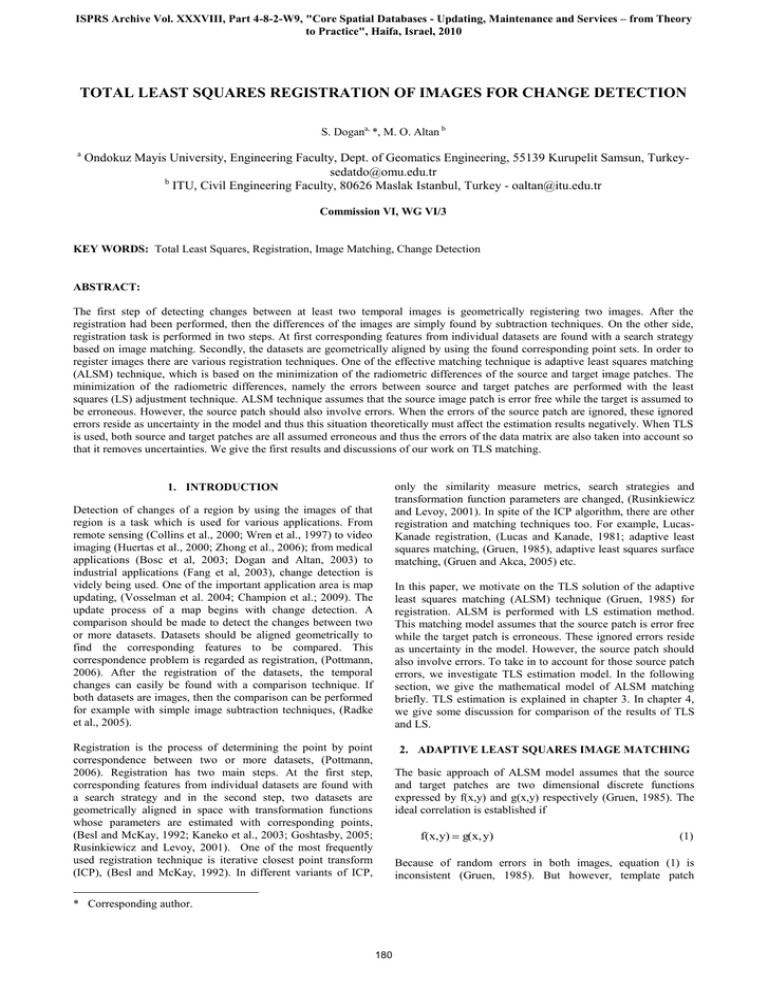
ISPRS Archive Vol. XXXVIII, Part 4-8-2-W9, "Core Spatial Databases - Updating, Maintenance and Services – from Theory to Practice", Haifa, Israel, 2010 TOTAL LEAST SQUARES REGISTRATION OF IMAGES FOR CHANGE DETECTION S. Dogana, *, M. O. Altan b a Ondokuz Mayis University, Engineering Faculty, Dept. of Geomatics Engineering, 55139 Kurupelit Samsun, Turkeysedatdo@omu.edu.tr b ITU, Civil Engineering Faculty, 80626 Maslak Istanbul, Turkey - oaltan@itu.edu.tr Commission VI, WG VI/3 KEY WORDS: Total Least Squares, Registration, Image Matching, Change Detection ABSTRACT: The first step of detecting changes between at least two temporal images is geometrically registering two images. After the registration had been performed, then the differences of the images are simply found by subtraction techniques. On the other side, registration task is performed in two steps. At first corresponding features from individual datasets are found with a search strategy based on image matching. Secondly, the datasets are geometrically aligned by using the found corresponding point sets. In order to register images there are various registration techniques. One of the effective matching technique is adaptive least squares matching (ALSM) technique, which is based on the minimization of the radiometric differences of the source and target image patches. The minimization of the radiometric differences, namely the errors between source and target patches are performed with the least squares (LS) adjustment technique. ALSM technique assumes that the source image patch is error free while the target is assumed to be erroneous. However, the source patch should also involve errors. When the errors of the source patch are ignored, these ignored errors reside as uncertainty in the model and thus this situation theoretically must affect the estimation results negatively. When TLS is used, both source and target patches are all assumed erroneous and thus the errors of the data matrix are also taken into account so that it removes uncertainties. We give the first results and discussions of our work on TLS matching. only the similarity measure metrics, search strategies and transformation function parameters are changed, (Rusinkiewicz and Levoy, 2001). In spite of the ICP algorithm, there are other registration and matching techniques too. For example, LucasKanade registration, (Lucas and Kanade, 1981; adaptive least squares matching, (Gruen, 1985), adaptive least squares surface matching, (Gruen and Akca, 2005) etc. 1. INTRODUCTION Detection of changes of a region by using the images of that region is a task which is used for various applications. From remote sensing (Collins et al., 2000; Wren et al., 1997) to video imaging (Huertas et al., 2000; Zhong et al., 2006); from medical applications (Bosc et al, 2003; Dogan and Altan, 2003) to industrial applications (Fang et al, 2003), change detection is videly being used. One of the important application area is map updating, (Vosselman et al. 2004; Champion et al.; 2009). The update process of a map begins with change detection. A comparison should be made to detect the changes between two or more datasets. Datasets should be aligned geometrically to find the corresponding features to be compared. This correspondence problem is regarded as registration, (Pottmann, 2006). After the registration of the datasets, the temporal changes can easily be found with a comparison technique. If both datasets are images, then the comparison can be performed for example with simple image subtraction techniques, (Radke et al., 2005). In this paper, we motivate on the TLS solution of the adaptive least squares matching (ALSM) technique (Gruen, 1985) for registration. ALSM is performed with LS estimation method. This matching model assumes that the source patch is error free while the target patch is erroneous. These ignored errors reside as uncertainty in the model. However, the source patch should also involve errors. To take in to account for those source patch errors, we investigate TLS estimation model. In the following section, we give the mathematical model of ALSM matching briefly. TLS estimation is explained in chapter 3. In chapter 4, we give some discussion for comparison of the results of TLS and LS. Registration is the process of determining the point by point correspondence between two or more datasets, (Pottmann, 2006). Registration has two main steps. At the first step, corresponding features from individual datasets are found with a search strategy and in the second step, two datasets are geometrically aligned in space with transformation functions whose parameters are estimated with corresponding points, (Besl and McKay, 1992; Kaneko et al., 2003; Goshtasby, 2005; Rusinkiewicz and Levoy, 2001). One of the most frequently used registration technique is iterative closest point transform (ICP), (Besl and McKay, 1992). In different variants of ICP, 2. ADAPTIVE LEAST SQUARES IMAGE MATCHING The basic approach of ALSM model assumes that the source and target patches are two dimensional discrete functions expressed by f(x,y) and g(x,y) respectively (Gruen, 1985). The ideal correlation is established if f(x,y) g(x, y) (1) Because of random errors in both images, equation (1) is inconsistent (Gruen, 1985). But however, template patch * Corresponding author. 180 ISPRS Archive Vol. XXXVIII, Part 4-8-2-W9, "Core Spatial Databases - Updating, Maintenance and Services – from Theory to Practice", Haifa, Israel, 2010 (template image) is assumed to be error free in the estimation model for simplification. To provide consistency, an error vector e(x,y) is added, resulting in, f(x, y) - e(x, y) In this case, the estimation procedure is an optimization problem given by (2) g(x, y) (6) Now the goal is to minimize the error vector e(x,y) which corresponds to radiometric differences of the error free template and erroneous target patches. where, m is number of unknowns an n is number of observations. Once a minimizing satisfying is called Since LS is a linear estimation model, equation (2) is linearized and fully affine image shaping parameters are involved into model. The resulting linear model is obtained as follows (Gruen, 1985). f(x,y) - e(x,y) g 0 (x, y) g x da11 g x x 0 da12 g x y0 da 21 g y db11 g y x 0 db12 g y y0 db 21 rs where, g x g 0 (x, y) and g y x is found then any x TLS solution and is corresponding TLS correction, (Golub and Loan, 1980; Akyilmaz, 2007; Huffel and Vandewalle, 1991; Golub and Reinsch, 1970; Golub, 1973). In the above equation, denotes the Frobenius norm. (3) In order to solve the basic TLS problem given by the equation (6), SVD can be used, as pointed in (Golub,1973) and more fully in (Golub and Loan, 1980) and (Huffel and Vandewalle, 1991). For solution of the Ax ≈ b, we write this functional relation as follows: g 0 (x, y) y In equation (3), da11, da12, da21, db11, db12, db21 are six affine parameters and rs is radiometric shift parameter. Above equation can be restated by adding a radiometric scale parameter rt, such that f(x,y)-e(x,y) = rt g(x,y) + rs. Now the equation (3) can be written in matrix form as A x = b – e where A is data (design) matrix, x is unknown vector and b is observation vector. The LS solution is obtained as (7) Now, SVD of the augmented matrix [A; b] is computed as follows: (8) (4) where, U= [ U1; U2 ], U1 = [ u1, ... , um ], U2 = [ um+1, ... , un ] and ui Є Rn, UT U = In. V = [ v1, ... , vm, vm+1 ], vi Є Rm + 1, VT V = Im+1. Σ = diag( σ1, ... , σm, σm+1 ) Є Rn×(m+1). In the next chapter, we give TLS estimation of the linear model given by equation (3) and in chapter (4) give some comparison results. In the equation (8), the rank of the matrix [A; b] is m+1. The rank must be reduced to m. For this purpose, Eckart-Young Minsky theorem is used, (Eckart and Young, 1936). After the rank reduction, the solution of the basic TLS is obtained by, x (AT P A)-1 A T P b where P is weight matrix. 3. TOTAL LEAST SQUARES ESTIMATION (9) In TLS, both the observation vector and the elements of data matrix (design matrix) are assumed to be erroneous, (Golub and Loan, 1980; Akyilmaz, 2007; Huffel and Vandewalle, 1991; Golub and Reinsch, 1970; Golub, 1973). If all of the elements of the data matrix are erroneous, this is called as basic TLS. If some columns of the data matrix are constant and thus error free, then this situation is called as mixed TLS. In the following two subsections these two types are given briefly. If vm+1,m+1 ≠ 0, then -1/ ( vm+1,m+1) [ v1, m+1, ... , vm, m+1]T and this belongs to column space of , and hence x solves the basic TLS problem, (Huffel and Vandewalle, 1991). 3.2 The Mixed LS-TLS Problem 3.1 The Basic TLS Problem In the mixed TLS model, one or more columns of the data matrix A is/are really error free. For example in matching problem, the column which corresponds to the radiometric shift parameter is constant and thus error free. In such cases, TLS solution must be obtained with the mixed model. The basic TLS model assumes that all of the elements of the data matrix A are erroneous. This situation is mathematically expressed as (5) Mixed LS-TLS means a mixture of LS and TLS. Here it can be thought that, fixed or error free columns of the data matrix A and their corresponding unknown parameters are just like in the case of LS. On the other hand, erroneous columns of A with their corresponding unknown parameters are just in the form of basic TLS. Then the problem may be considered as the mixture where, Δb is error vector of observations and ΔA is error matrix of data matrix A. Both errors are assumed independently and identically distributed with zero mean and with same variance. 181 ISPRS Archive Vol. XXXVIII, Part 4-8-2-W9, "Core Spatial Databases - Updating, Maintenance and Services – from Theory to Practice", Haifa, Israel, 2010 of LS and basic TLS. According to this approach, the first step of the formulation begins by separating fixed columns of A and their corresponding x components from the rest of the erroneous columns of A and rows of x respectively. This procedure can be defined as follows: 4. DISCUSSION Theoretically, the TLS estimation method gives better results than LS. When the theory of the TLS and its minimizer norms are investigated, it is seen that it gives equivalent results with LS in the worst case and gives better results in all other cases. In this preliminary work, we have investigated the generic TLS model which means that it has a unique solution (Huffel, 1991). But there are situations where TLS has no unique solution. Then non generic solutions are possible (Huffel, 1991). When considering both the ill posed nature and iterative procedure of the image matching problem, it is possible to be face to face non generic cases. So the implementation algorithm of the TLS should cover all possible cases. In this preliminary work we have dealt only with the generic solution as mentioned before. Given a set of n linear equations in m unknown vector x, such that: (Golub and Loan, 1980; Huffel and Vandewalle, 1991; Akyilmaz, 2007). (10) Partition data matrix A and x vector as follows: On the other side, comparison of TLS and LS results in a compact and clear way is also a difficult task. Statistical properties of the LS are well known. But stating the statistical relations between the data errors and the observations errors is still problematic. For these purposes, some approaches based on titration models and error equilibration models are used. At the moment we are studying on error propagation theory for statistical interpretation of the TLS solution given in the previous chapter. (11) where m1 is the number of fixed columns. Then mixed LS-TLS problem seeks to (12) once a minimizing satisfying solution” and corresponding mixed Vandewalle, 1991). Here, in order to show the results of the TLS and LS matching, we compare the manually measured coordinates of the points to TLS and LS matched coordinates. This approach is not so appropriate for evaluation and comparison but however may give some insight to the readers. is found, then any is called “mixed LS-TLS is the LS-TLS correction, (Huffel and Solution of equation (12) begins with computing a QR factorization of the “known” columns and then solving the TLS problem of the reduced dimension. Let matrix A=[A1; A2] be given whose first m1 columns A1 have no error and have full column rank. Then the algorithm is as follows: Figure 1. Source image (left), target image (right); with corresponding points Perform m1 Householder transformations Q on the matrix [A; b] so that, In Figure 1, two sample images with corresponding points are shown. There are significant scale change and rotation between two images. In Figure 2, source patch of point p1 and corresponding matched patches by TLS and LS are shown respectively. (13) where R11 is (m1×m1) upper triangular matrix. R12 is (m1×(mm1)) matrix, R22 is ((n-m1)×(n-m1)) matrix, R1b is (m1×1) matrix and R2b is ((n-m1)×1) matrix. (Akyilmaz, 2007; Huffel and Vandewalle, 1991). Figure 2. Source patch (left), TLS matched target patch (middle) and LS matched target patch (right) Now in order to solve mixed LS-TLS problem, at first x2 is computed by As seen in Figure 2, TLS result seems to better fit to the source location. In Table 1, coordinates of four matched points are shown. The results of TLS matching are in the first column, the LS results are in the second column of Table 1. Third column shows the manually measured target coordinates. The coordinate values are in the pixel unit. (14) To solve equation (14), the basic TLS solution given by equation (9) is used. Later, x1 is computed by back substitution of the estimated x2 in the following equations; (15) and thus the solution is obtained. 182 ISPRS Archive Vol. XXXVIII, Part 4-8-2-W9, "Core Spatial Databases - Updating, Maintenance and Services – from Theory to Practice", Haifa, Israel, 2010 P t. # 1 2 3 4 TLS x LS y 458.584, 119.517 769.850, 110.739 523.408, 226.874 892.167, 273.025 x abnormalities. Optical 3D Measurement Conference, Zurich, vol. 1, pp. 148-155. Manual y 458.349, 122.287 770.250, 112.050 524.342, 226.358 892.555, 273.438 x y 459.130, 119.933 770.067, 112.067 523.735, 226.330 892.200, 272.930 techniques VI Eckart, G.; Young, G., 1936. The approximation of one matrix by another of lower rank. Psychometrica, 1, pp. 211-218. Fang, C.Y., Chen, S.W., Fuh, S., 2003, Automatic change detection of driving environments in a vision based driver assistance system, IEEE Trans. Neural Networks, 14(3), pp. 646-657. Table 1. Matched coordinates. We assume that the manually measured coordinates are correct. Then the corresponding differences of the coordinate values in the table are the errors of the corresponding coordinates. Their mean squared errors are σxTLS = ± 0.337 pixel, σyTLS = ± 0.748599 pixel, σxLS = ± 0.533368 pixel and σyLS = ± 1.204206 pixel. As seen the results are unacceptable both for TLS and LS. For LS matching, during the matching procedure, an appropriate test procedure to exclude the nondeterminable parameters are required. The same problem is also valid for TLS matching. But however, the given results in Table 1 and our previous results always shown that the TLS results are more realistic. Of course there are many problems to be answered for TLS matching. For example, when data matrix is assumed erroneous, it means that the estimation model will modify the data. In this case, what can be said about the radiometric shift and scale parameters? Should they be included in to model? There are various questions to be answered and these are interest of our future works. Golub, G. H., 1973. Some modified matrix eigenvalue problems. SIAM Review, 15, pp. 318-344. Golub, G. H., Loan, C.F.V., 1980. An analysis of the total least squares problem. SIAM Journal of Numerical Analysis, 17, pp. 883-893. Golub, G. H., Reinsch, C., 1970. Singular value decomposition and least squares solutions. Numerische Mathematik, 14, pp. 403-420. Goshtasby, A. A., 2005. 2D and 3D Image Registration For Medical, Remote Sensing, And Industrial Applications; 1st Ed.; Wiley Interscience: New Jersey, USA, 2005; pp. 107-141. Gruen, A., 1985. Adaptive least squares correlation: a powerful image matching technique. South African Journal of Photogrammetry, Remote Sensing and Cartography, 14(3), pp. 175-187. 5. CONCLUSION Gruen, A., Akca, D., 2005. Least squares 3D surface and curve matching. ISPRS Journal of Photogrammetry and Remote Sensing, 59(3), pp. 151-174. In this paper, we investigated the TLS estimation method for data registration problems to find the corresponding match points which are necessary for geometrically register the datasets to each other. And we applied TLS to adaptive least squares matching technique. Although there are still many problems to be solved for TLS matching, this preliminary work shows that it is an effective and more realistic approach than LS. In the worst case, TLS gives the equivalent results as LS and in all other cases it is better than LS. Huertas, A., Nevatia, R., 2000. Detecting changes in aerial views of manmade structures, Image Vision Computation, 18(8), pp. 583-596. Huffel, S.V., Vandewalle, J., 1991. The Total Least Squares Problem: Computational Aspects and Analysis, 1st Ed.; SIAM: Philadelphia, USA. 6. REFERENCES Kaneko, S., Tomonori, K., Miyamoto, A., 2003. Robust matching of 3D contours using iterative closest point algorithm improved by M-estimation. Pattern Recognition, 36(9), pp. 2041-2047. Akyilmaz, O., 2007.Total least squares solution of coordinate transformation. Survey Review, 39, pp. 68-80. Besl, P. J., McKay, N. D., 1992. A method for registration of 3D shapes. IEEE Transactions on Pattern Analysis and Machine Intelligence, 14(2), 239-256. Lucas, B.D.; Kanade, T. An iterative registration technique with an application to stereo vision. Proc. 7th Int. Joint Conf. on Artificial Intelligence (IJCAI); Vancouver, British Columbia, 1981; pp. 674-679. Bosc, M., Heitz, F., Armspach, J.P., Namer, I., Gounot, D., Rumbach, L., 2003. Automatic change detection in multimodel sreial MRI: application to multiple sclerosis lesion evolution, Neuroimage, 20, pp. 643-656. Pottmann, H., 2006. Geometry and convergence analysis of algorithms for registration of 3D shapes. International Journal of Computer Vision, 67(3), pp. 277-296. Champion, N., Stamon, G. Pierrot-Deseilligny, M., 2009. Automatic GIS updating from high resolution satellite images. MVA2009 IAPR Conference on Machine Vision Applications, May 20-22, Yokohama, JAPAN Radke, R. J., Andra, S., Al-Kofahi, O., Roysam, B., 2005. Image change detection algorithms: a systematic survey. IEEE Transactions on Image Processing, 14 (3), pp. 294-307. Collins, R., Lipton, A. and Kanade, T., 2000. Introduction to the special section on video surveillance, IEEE Transactions on Pattern Analysis and Machine Intelligence, 22(8), pp. 745-746. Rusinkiewicz, S., Levoy, M., 2001. Efficient variants of the ICP algorithm. In Proc. of Third International Conference on 3D Digital Imaging and Modeling (3DIM’01), pp. 145-152. Dogan S., Altan M.O., 2003. 3D modeling of human face and brain by using CT, MR and digital images for finding Vosselman, G., Gorte, B.G.H., Sithole, G., 2004. Change Detection for Updating Medium Scale Maps Using Laser Altimetry. The International Archives of the Photogrammetry, 183 ISPRS Archive Vol. XXXVIII, Part 4-8-2-W9, "Core Spatial Databases - Updating, Maintenance and Services – from Theory to Practice", Haifa, Israel, 2010 Remote Sensing and Spatial Information Sciences, Vol. 34, Part B3. Wren, C.R., Azarbayejani, A., Darrel, T., Pentland, A., 1997. Pfinder: real-time tracking of the human body, IEEE Transactions on Pattern Analysis and Machine Intelligence, 19(7), pp. 780-785. 184
